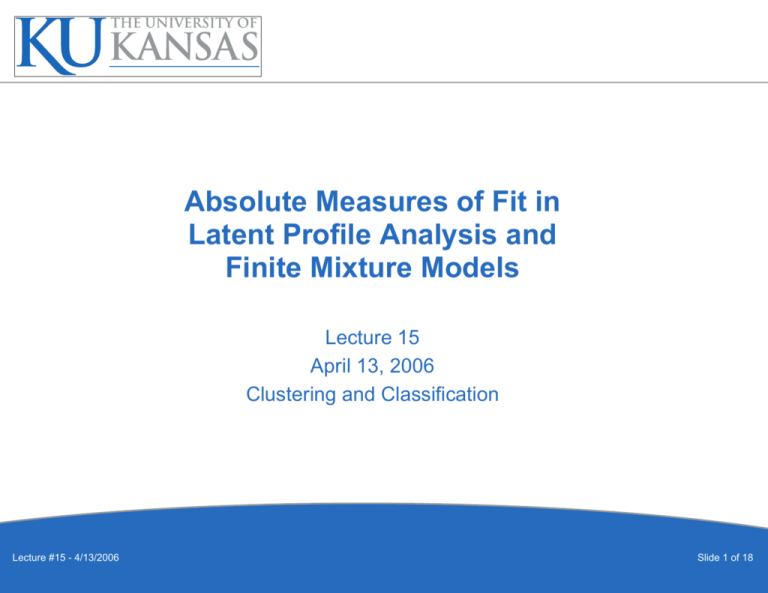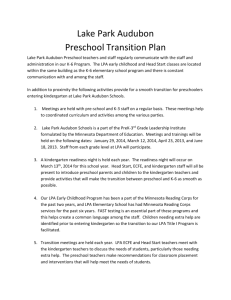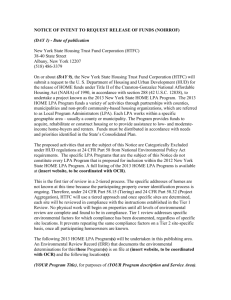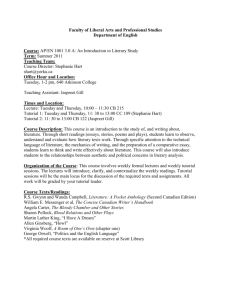Absolute Measures of Fit in Finite Mixture Models
advertisement

Absolute Measures of Fit in Latent Profile Analysis and Finite Mixture Models Lecture 15 April 13, 2006 Clustering and Classification Lecture #15 - 4/13/2006 Slide 1 of 18 Today’s Lecture Overview ➤ Today’s Lecture ● Model fit assessment in Finite Mixture Models (as realized through LPA). ● Absolute versions of model fit for mixtures of continuous distributions. ● Why absolute measures of fit matter. Latent Profile Analysis LPA as a FMM LPA Example #1 Absolute Fit Confidence Regions Wrapping Up Lecture #15 - 4/13/2006 Slide 2 of 18 Finite Mixture Models ● Overview Recall from last time that we stated that a finite mixture model expresses the distribution of X as a function of the sum of weighted distribution likelihoods: Latent Profile Analysis LPA as a FMM ➤ Finite Mixture Models ➤ LCA as a FMM ➤ MVN ➤ LPA with MVN ➤ LCA as a FMM LPA Example #1 f (X) = G X ηg f (X|g) g=1 ● We are now ready to construct the LPA model likelihood. ● Here, we say that the conditional distribution of X given g is a sequence of independent normally distributed variables. Absolute Fit Confidence Regions Wrapping Up Lecture #15 - 4/13/2006 Slide 3 of 18 Latent Class Analysis as a FMM Overview Using some notation of Bartholomew and Knott, a latent profile model for the response vector of p variables (i = 1, . . . , p) with K classes (j = 1, . . . , K): Latent Profile Analysis LPA as a FMM ➤ Finite Mixture Models ➤ LCA as a FMM ➤ MVN ➤ LPA with MVN ➤ LCA as a FMM f (x) = K X j=1 ηj p Y 1 q exp 2 2πσij i=1 −(xi − µij )2 2 σij ! ● ηj is the probability that any individual is a member of class j (must sum to one). ● xi is the observed response to variable i. ● µij is the mean for variable i for an individual from class j. ● 2 σij is the variance for variable i for an individual from class j. LPA Example #1 Absolute Fit Confidence Regions Wrapping Up Lecture #15 - 4/13/2006 Slide 4 of 18 MVN ● Overview f (x) = Latent Profile Analysis LPA as a FMM ➤ Finite Mixture Models ➤ LCA as a FMM ➤ MVN ➤ LPA with MVN ➤ LCA as a FMM Confidence Regions Wrapping Up Lecture #15 - 4/13/2006 1 (2π)p/2 |Σ| −(x−µ)Σ e 1/2 −1 (x−µ)/2 ● The mean vector is µ. ● The covariance matrix is Σ. ● Standard notation for multivariate normal distributions is Np (µ, Σ). ● Visualizing the MVN is difficult for more than two dimensions, so I will demonstrate some plots with two variables - the bivariate normal distribution. LPA Example #1 Absolute Fit The multivariate normal distribution function is: Slide 5 of 18 Expressing LPA with MVN ● Recall the LPA model has the strict assumption of local independence of variables given class. ● So, for each class j, we estimate a mean vector, µj , and a diagonal covariance matrix, Σj : 2 µ1j σ11 0 ... 0 2 ... 0 µ2j 0 σ21 µj = .. .. .. .. Σj = .. . . . . . Overview Latent Profile Analysis LPA as a FMM ➤ Finite Mixture Models ➤ LCA as a FMM ➤ MVN ➤ LPA with MVN ➤ LCA as a FMM µnj LPA Example #1 Absolute Fit Confidence Regions ● 0 0 2 . . . σij We can then reexpress our LPA model by the MVN density (this will follow us throughout the remainder of the mixtures of MVN distributions). Wrapping Up Lecture #15 - 4/13/2006 Slide 6 of 18 Latent Class Analysis as a FMM Overview Using some notation of Bartholomew and Knott, a latent profile model for the response vector of p variables (i = 1, . . . , p) with K classes (j = 1, . . . , K): Latent Profile Analysis LPA as a FMM ➤ Finite Mixture Models ➤ LCA as a FMM ➤ MVN ➤ LPA with MVN ➤ LCA as a FMM f (x) = j=1 ηj 1 (2π)p/2 |Σj |1/2 −1 exp −(x − µj )Σj (x − µj )/2 ● ηj is the probability that any individual is a member of class j (must sum to one). ● xi is the observed response to variable i. ● µj is the mean vector for class j. ● Σj is the diagonal covariance matrix for class j - implying conditional independence of variables. LPA Example #1 Absolute Fit K X Confidence Regions Wrapping Up Lecture #15 - 4/13/2006 Slide 7 of 18 LPA Example ● To illustrate the process of LPA, consider an example using Fisher’s Iris data. Latent Profile Analysis ● The Mplus code is found on the next few slides. LPA as a FMM ● We will use the Plot command to look at our results. LPA Example #1 ➤ Results ● Also, this time we will try fitting multiple classes to see if our results change from time to time, and how the fit statistics look for each type of solution. ● Specifically, we will compare a two-class solution to a three-class solution (the correct one) and a 4-class solution. Overview Absolute Fit Confidence Regions Wrapping Up Lecture #15 - 4/13/2006 Slide 8 of 18 title: 2-Class Latent Profile Analysis of Fisher’s Iris Data; data: file=iris.dat; variable: names=x1-x4; classes=c(2); analysis: type=mixture; model: %OVERALL% %C#1% x1-x4; %C#2% x1-x4; OUTPUT: TECH1 TECH5 TECH8; PLOT: TYPE=PLOT3; SERIES IS x1(1) x2(2) x3(3) x4(4); SAVEDATA: FILE IS myfile2c.dat; SAVE = CPROBABILITIES; 8-1 title: 3-Class Latent Profile Analysis of Fisher’s Iris Data; data: file=iris.dat; variable: names=x1-x4; classes=c(3); analysis: type=mixture; model: %OVERALL% %C#1% x1-x4; %C#2% x1-x4; %C#3% x1-x4; OUTPUT: TECH1 TECH5 TECH8; PLOT: TYPE=PLOT3; SERIES IS x1(1) x2(2) x3(3) x4(4); SAVEDATA: FILE IS myfile3c.dat; SAVE = CPROBABILITIES; 8-2 title: 4-Class Latent Profile Analysis of Fisher’s Iris Data; data: file=iris.dat; variable: names=x1-x4; classes=c(4); analysis: type=mixture; model: %OVERALL% %C#1% x1-x4; %C#2% x1-x4; %C#3% x1-x4; %C#4% x1-x4; OUTPUT: TECH1 TECH5 TECH8; PLOT: TYPE=PLOT3; SERIES IS x1(1) x2(2) x3(3) x4(4); SAVEDATA: FILE IS myfile4c.dat; SAVE = CPROBABILITIES; 8-3 Model Results ● The table below shows the results of our models in for each class solution: Model 2-class 3-class 4-class Parameters 17 26 35 Log L -386.185 -307.178 -264.848 AIC 806.371 666.355 599.695 BIC 857.551 744.632 705.067 Entropy 1.000 0.948 0.948 ● Based on AIC and BIC, we would choose the 4-class solution (and probably should try a 5-class model). ● Note that by adding multiple starting points, the 3-class and 4-class solutions started to demonstrate problems with: ● ✦ Convergence in some iterations. ✦ Multiple modes - something to think about! Any guesses as to why these problems didn’t show up in the two-class solution? Lecture #15 - 4/13/2006 Slide 9 of 18 More Fit Info Needed? ● The model fit section just discussed is often where many researchers stop in their evaluation of a LPA or FMM solution. ● But do we really know whether what we did resembles anything about the nature of our data? ● In other methods for analysis, for instance Structural Equation Modeling, we are very concerned that our model parameters resemble the observed characteristics of the data. ● For instance, the discrepancy between the observed covariance matrix and estimated covariance matrix is used in several goodness-of-fit indices. ● Well, similar measures can be constructed in FMM. Overview Latent Profile Analysis LPA as a FMM LPA Example #1 Absolute Fit Confidence Regions Wrapping Up Lecture #15 - 4/13/2006 Slide 10 of 18 What Can We Do? ● We can begin look at our distributional assumptions and do some bivariate plots featuring confidence regions. ● We can also use the estimated parameters of our solution to “predict” what the moments of the variables should be like: Overview Latent Profile Analysis LPA as a FMM ✦ The mean for each item (we will not find much variation here regardless of model). ✦ The covariance matrix for all pairs of items (this would be analogous to what we do in SEM). ✦ Both of these can be done either by statistical properties of the models (hard sometimes) or by simulation (too easy sometimes). LPA Example #1 Absolute Fit Confidence Regions Wrapping Up ● Lecture #15 - 4/13/2006 We can also look at the proportion of observations we would expect to classify correctly for each solution (although this is somewhat problematic). Slide 11 of 18 Confidence Regions ● Just as with univariate statistics, we can construct “confidence intervals” for the mean vector for multivariate inference. ● These “intervals” are no longer for a single number, but for a set of numbers contained by the mean vector. ● The term Confidence Region is used to describe the multivariate confidence intervals. ● In general, a 100 × (1 − α)% confidence region for the mean vector of a p-dimensional normal distribution is the ellipsoid determined by all µ such that: Overview Latent Profile Analysis LPA as a FMM LPA Example #1 Absolute Fit Confidence Regions ➤ Building CRs Wrapping Up nj X̄ − µj Lecture #15 - 4/13/2006 ′ Σ−1 j X̄ − µj p(nj − 1) Fp,nj −p (α) = (nj − p) Slide 12 of 18 Building CRs - Population ● To build confidence regions, recall our last lecture about the multivariate normal distribution... Overview Specifically: Latent Profile Analysis (x − µ)Σ −1 2 (x − µ) = χp (α) LPA as a FMM LPA Example #1 provides the confidence region containing 1 − α of the probability mass of the Absolute Fit MVN distribution. Confidence Regions ➤ Building CRs Wrapping Up ● We then calculated the axes of the ellipsoid by computing the eigenvalues and eigenvectors of the covariance matrix Σ: Specifically: (x − µ)Σ−1 (x − µ) = c2 √ has ellipsoids centered at µ, and has axes ±c λi ei . Lecture #15 - 4/13/2006 Slide 13 of 18 Building CRs - Sample ● A similar function is used to develop the confidence region for the multivariate mean vector based on the sample mean (x̄) and covariance matrix (S̄). ● Note that because we are taking a sample rather than the population, the distribution of the squared statistical distance is no longer χ2p (α) but rather p(n−1) (n−p) Fp,n−p (α) ● This means that theq confidence region is centered at (x̄), √ and has axes ± λi p(n−1) (n−p) Fp,n−p (α)ei . Overview Latent Profile Analysis LPA as a FMM LPA Example #1 Absolute Fit Confidence Regions ➤ Building CRs Wrapping Up Lecture #15 - 4/13/2006 Slide 14 of 18 LPA CRs ● Let’s assume, for simplicity (because nj is only estimated), that the number of observations in each class is infinite. ● We could then draw ellipses for each class and see how they relate to our data. ● In this case, we have diagonal matrices for our covariance matrices within class. ● Our ellipses are somewhat difficult to draw in R. ● Difficulty shouldn’t stop you from doing so, however. Overview Latent Profile Analysis LPA as a FMM LPA Example #1 Absolute Fit Confidence Regions ➤ Building CRs Wrapping Up Lecture #15 - 4/13/2006 Slide 15 of 18 LPA Simulation ● Given the difficulty in getting some plots to work, we can turn to simulation to achieve our fit evaluation objectives. ● It is here we will often see discrepancies between the model estimates and the data. ● Simulation is considerably easier than finding multivariate confidence ellipses, and can often be done much quicker. ● To demonstrate, look at the two text files with this week’s lecture. Overview Latent Profile Analysis LPA as a FMM LPA Example #1 Absolute Fit Confidence Regions ➤ Building CRs Wrapping Up Lecture #15 - 4/13/2006 Slide 16 of 18 Final Thought ● Overview Latent Profile Analysis LPA as a FMM LPA Example #1 ● Absolute Fit Confidence Regions Wrapping Up ➤ Final Thought ➤ Next Class ● ● Lecture #15 - 4/13/2006 Absolute measures of fit are available in FMM and will provide you with understandable and interpretable numbers and plots. The difficulty in evaluating model fit should not make you run from doing so (I suggest this to get you ready to write and review papers). Because of the complexity in the modeling aspects of FMM, people often forget about absolute measures of fit - which is a bad thing to do. When using absolute measures, you could be simply looking at two poorly-fitting models. Slide 17 of 18 Next Time ● Estimation week begins on Tuesday - consider me one happy person. ● Our next class: Overview Latent Profile Analysis ✦ Marginal ML estimation of FMM. ✦ Estimation topics in general. LPA as a FMM LPA Example #1 Absolute Fit Confidence Regions Wrapping Up ➤ Final Thought ➤ Next Class Lecture #15 - 4/13/2006 Slide 18 of 18









